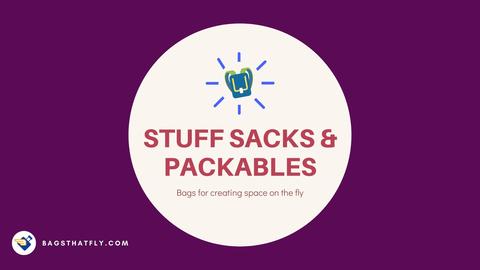
Packable bags, stuff sacks, and foldable backpacks—these are all bags that can compress down to a small size. Fully compressed, most will take up less space than a small tomato or clementine. When you need more carrying space, they’ll unfurl to hold as much as 35L of volume.
Put into perspective, that’s as much as space as a small roller suitcase will provide. And this ability to pack and expand makes them handy for any traveler.
How these packs work
Packables share many properties with plastic bags. They’re thin and lightweight enough to stuff unobtrusively into any corner. The key difference is that they’re also exceptionally tough. That’s in large part due to their use of ripstop nylon.
Ripstop is a special reinforced weave that resists ripping and tearing. You’ll find ripstop used in tarps, tents, and clothing. When used in bags, ripstop is commonly coated or treated to make them more waterproof.

Despite being able to fit 35L expanded, the Ultralight Packable Day Pack from AmazonBasics is pocket-sized when fully compressed
When we held our first ripstop bag five years ago, our reaction was that of skepticism. It simply felt too thin and too fragile to hold up. That doubt has fully dissipated. Through the years, we’ve only seen one rip form, a tiny 2mm one that hasn’t lengthened over time. We’re confident that ours will last another five years easily.
Great convenience, mediocre comfort
Packables are light and durable, but they’re not quite built for comfort. Since they’re meant to take up as little space as possible, you won’t find much padding on these bags. As a result, these bags tend to “transfer” the bumps and bends of their contents. Expect to feel jagged edges and corners if you’re packing anything aside from fabrics and clothing.
Less expensive packs also tend to use thin straps that dig in with heavier bags. That said, we’re seeing a lot of newer models with wider straps. These distribute weight more evenly across your shoulders making them more comfortable to carry on your back.

Thin, thin, thin: Ultralight Stuff Pack from Osprey
If you’re looking for additional comfort, consider packing in some cushioning. We like to throw a jacket or towel in to give our bags shape and to pad.
When traveling with both packable and another larger suitcase, consider contents around. Heavier, more “prodding” items should stay in the larger suitcase. Softer, lighter, items should go into your packable bag.
A few use cases for your consideration
Whether you’re traveling or running errands, you’ll undoubtedly come upon moments where you need more carrying space. Here are a few common ways you can use yours.
Bring home more souvenirs
If you tend to buy a lot of souvenirs, packable bags can make bringing them home easier. Just expand your pack to make space for your souvenirs.
That beats the old school way of transporting souvenirs. No longer will you need to bring an extra suitcase or rely on shopping bags to do the trick. A packable bag is far more durable than the latter without sacrificing the space it takes to pull off the former.
A daypack for long walks
We can’t tour a city by foot or trek through the hills without bringing a daypack. We’re too reliant on one to keep our essentials—trail maps, sunscreen, snacks, water, and a light jacket.
More often than not though, a daypack is a luxury. Unless we’re using one as our personal item, it’s usually too bulky to bring.

Above: How the Packable Lightweight Travel Hiking Backpack from Outlander packs down
That’s where foldable backpacks come into play. Like stuff packs, they’re also lightweight. They do differ in that they’re designed more for active use than for sheer carrying capacity.
Most foldable backpacks we’ve seen offer lightly padded straps. Some also offer compression straps and mesh pockets we typically won’t find on simpler stuff packs.
They might not be as comfortable as “full” daypacks, but they’re good substitutes, especially if your goal is to pack light.
A makeshift toiletry bag / wet pack
Long ago, before we bought our first toiletry bag, we used our stuff pack to hold our toiletries. This worked surprisingly well. In one instance, a shampoo bottle burst open, but none of it leaked from the ripstop pack. We’ll count that as a success.
One major flaw to using stuff packs as toiletry bags is that they offer no organization. If you use yours as one, expect everything—soaps, shampoos, toothbrush, and makeup—to mix and shuffle together.
A handy errand bag
Lastly, the stuff pack makes for a great general purpose bag, especially for urban dwellers. We’ve used ours to help us carry home groceries, books from a library, and packages from the office. It’s not inconceivable to use one as a lighter backpack too when we don’t need the padding or pockets of a full backpack.
Packable bags we like
The market’s exploded with the number of packable bags available in recent years. Competitors, from large brands to lesser known upstarts, have made several variants of the once-simple ripstop stuff pack. Here are some of our favorites.
Osprey Ultralight Stuff Pack, Tropic Teal, One Size
Available from: Amazon
Sea to Summit Ultra-Sil Day Pack (Gold, 20-Liter)
Available from: Amazon











Comments